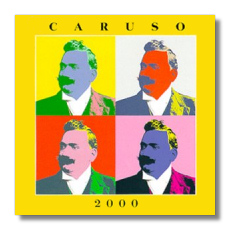
The Internet's Premier Classical Music Source
Related Links
- Latest Reviews
- More Reviews
-
By Composer
-
Collections
DVD & Blu-ray
Books
Concert Reviews
Articles/Interviews
Software
Audio
Search Amazon
Recommended Links
Site News
 CD Review
CD Review
Caruso 2000

Enrico Caruso, tenor
Vienna Radio Symphony Orchestra/Gottfried Rabi
ORF/RCA 74321-69766
We've all seen photographs, television commercials, and movies in which a character is inserted into a scene where he doesn't belong. Now this has been done – for the first time, as far as I know – for classical music. On this disc, the engineers have used computers and electronic filters to remove the tinny orchestral sound and all the surface noise of 16 of Caruso's acoustic recordings (from 1906 to 1920) and over-dubbed modern orchestral accompaniments recorded in 1999. The results are fascinating but problematical.
The orchestra sounds fine, and under Rabi's direction, the joins are almost seamless; they do an excellent job of adapting to the singer's idiosyncrasies – held notes, clipped accents, rhythmic irregularities and all. However, the vivid orchestral sound has the effect of emphasizing the sonic limitations of the recorded voice, with its lack of overtones and limited dynamic range; somehow they are more apparent than when we hear them in their original context. Also, all the filtering has made Caruso's incisive attacks and glorious tone somewhat fuzzy at the edges; the disc includes a comparison track of what is apparently a direct transfer of the original recording of his classic "Vesti la giubba", and there is more life and juice in it than in the modernized version. Of course, Caruso's voice is glorious – his ravishing "O Paradiso" by itself makes clear why he still stands head and shoulders above all his successors – but we already knew that., This experiment probably isn't worth repeating for anyone else, and given the cost of hiring a full symphony orchestra, it probably won't be. But it was certainly worth trying, at least once.
Copyright © 2000, Alexander J. Morin


















